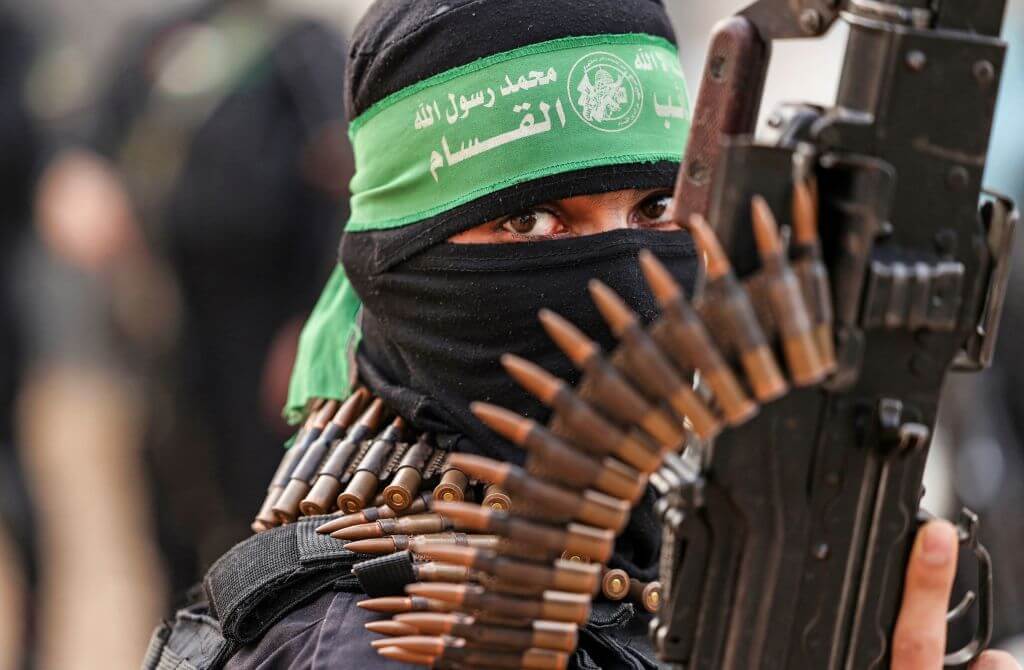Who is Hamas, the militant group that attacked Israel and controls Gaza?
The militant Islamist group that has ruled the Gaza Strip for the last 16 years distinguishes itself by projecting an image as a pragmatic actor alongside its commitment to the complete destruction of the State of Israel

A member of Ezzedine al-Qassam Brigades, military wing of the Palestinian Hamas movement, takes part in a parade in Gaza City on November 14, 2021. Photo by Getty Images
This article originally appeared on Haaretz, and was reprinted here with permission. Sign up here to get Haaretz’s free Daily Brief newsletter delivered to your inbox.
What are the origins of Hamas?
Hamas, the militant Palestinian Islamist group controlling the Gaza Strip, was born in 1988 following the first intifada – the popular Palestinian uprising against Israel.
The name ‘Hamas’ is an acronym for Harakat al-Muqawama al-Islamiya (“Islamic Resistance Movement”) as well as being an Arabic word meaning “zeal.”
The movement distinguished itself from the group that had until then dominated Palestinian political life – the Palestine Liberation Organization – by its devotion to Islam and its charter declaring an uncompromising commitment to the complete destruction of the State of Israel. It opposed the Oslo Accords agreement between Israel and the PLO in 1993.
Its military wing, the Iz al-Din al-Qassam Brigades, was devoted to that purpose, and as a result Hamas is branded a terrorist group by most Western countries. But its second distinctive characteristic, which contributed greatly to its popularity among Palestinians, was the development of a social welfare organization which opened schools and clinics that have been more effective and efficient than those of the PLO and its political party, Fatah.
This is what launched it as a political force. That popularity came to the forefront in 2005, when Israel, at the initiative of Prime Minister Ariel Sharon, pulled Israeli troops out of Gaza and evacuated settlements there, hoping that Israel would eventually live harmoniously with a Palestinian entity as its neighbor, paving the way to a Palestinian state. That disengagement plan was derailed when Hamas defeated Fatah in Gaza’s 2006 election, and a bitter and bloody rivalry between the two led to a total ouster of all Fatah presence from the Strip in 2007.
What has Hamas rule and its relationship with Israel brought?
The history of the relationship between Israel and Hamas leaders in Gaza who rule over the Strip’s two million residents is one of conflict and dependence.
Since Hamas took hold, Israel – along with the Strip’s other neighbor, Egypt – has maintained a blockade on Gaza. The blockade and the fact that Gaza’s leaders are branded as terrorists has kept it isolated and poverty-stricken.
Hamas remains ideologically committed to Israel’s destruction, and becomes a base for terror operations against the Jewish state, including shooting attacks and bus bombings, but in recent years most dramatically in the form of rocket fire launched from Gaza’s territory.
Over time, Hamas’ capabilities have grown from the ability to shoot rockets into the southern part of Israel surrounding the Strip to capabilities to strike Tel Aviv, Jerusalem and other cities in the heart of Israel. On four occasions, the exchange of fire between the two has escalated into full-fledged war.
Despite its enmity with Hamas, Israel has, over the years, viewed it as a useful counterweight to Fatah. The Israeli right, in particular, has viewed the bitter Hamas-Fatah rift as a guarantee that Palestinian leadership will never unite in support of a peace agreement, or even a unified front to demand Palestinian independence.
What events led to the current conflict?
The last major clash between Israel and Hamas took place in May 2021, when rockets from Gaza killed 13 Israelis and Israeli shelling killed at least 256 Palestinians. Like most of the previous conflicts, it ended with an agreement brokered by Egypt, with U.S. encouragement and backing.
Since then, it was generally perceived by Israel that Hamas has been taking a step back from continual armed hostilities in favor of more responsible, pragmatic leadership, becoming more politicized and wary of armed resistance that might result in massive Israeli retaliation, devastate its infrastructure and threaten its control.
It was, Israeli analysts believed, leaving the more brash aggression to extreme splinter groups like Palestinian Islamic Jihad, which had fewer military capabilities. In May 2023, Prime Minister Benjamin Netanyahu launched Operation Shield and Arrow against PIJ. Hamas bent over backward to signal that it was not involved in the PIJ’s firing of rockets into Israel in order to encourage Israel to target only PIJ facilities in retaliation, and avoid Hamas targets and other wider operations in Gaza.
Presumably, it was such behavior that lulled Israel’s civilian and military leadership into the massive tactical failure that led to the devastating surprise attack on October 7. There was also a belief that Israeli financial help to Hamas (indirectly, by encouraging countries like Qatar to offer more aid), allowing more Gazan workers into Israel and increased UNRWA projects would stave off any possible appetite for military escalation and conflict.
The shocking and overwhelming nature of Hamas’ broad military operation on October 7 – including the murderous infiltration into southern Israel and the ensuing massacres justified by Gazan militant groups as a “defense of Al-Aqsa,” the holy compound in Jerusalem known to Jews as the Temple Mount, showed that despite 35 years of confronting Hamas, Israel still doesn’t understand it at all.














